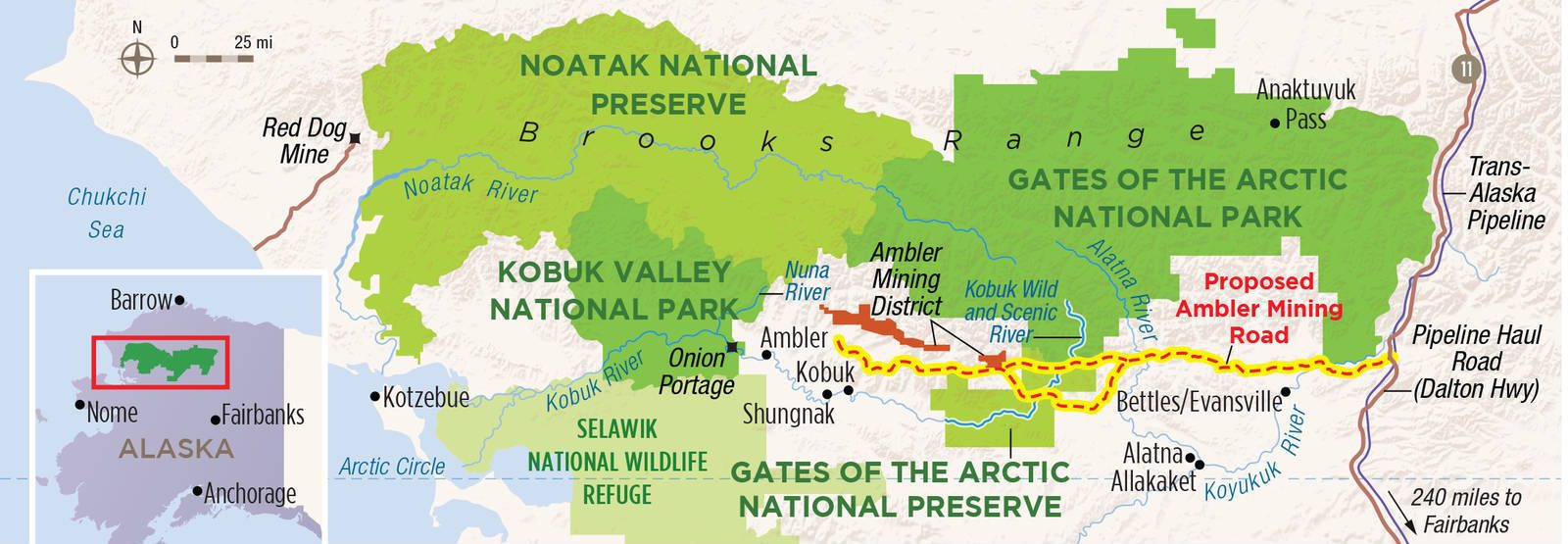
Two “under the radar” projects that threaten the Arctic
Two projects – the Ambler road and the Willow oil and gas extraction proposals – would dramatically diminish the health of Arctic communities, wildlife, and natural places. The public comment periods for both projects’ draft environmental impact statements end Oct. 29.
Now is the time to act to stop the degradation of Alaska’s Arctic.

Though geographically distinct, both proposals would disrupt caribou migrations, destroy wildlife habitat, pollute waterways and land, degrade and reduce access to traditional foods, and diminish the health of Arctic communities already suffering the impacts of climate change.
The Ambler road proposal would construct a 200-plus-mile state-funded gravel driveway west from the Dalton Highway to the Ambler mining district for the benefit of a Canadian mining company. ConocoPhillips’ Willow proposal would put massive oil and gas infrastructure across the western Arctic Slope and within the National Petroleum Reserve-Alaska, including areas designated for protection because of their ecological importance to animals and people. The Bureau of Land Management is rushing to permit both projects at the same time.
Ambler’s private gravel road to ruin
Aside from being a budget black hole, the proposed driveway to the Ambler Mining District would cross 2,900 streams and 11 major rivers, threatening the water systems of the southern Brooks Range and the salmon, whitefish, and sheefish in the Kobuk River watershed. The gravel road would also disturb the migration of the Western Arctic Caribou Herd—one of the longest land migrations on earth—and cross 20 miles of Gates of the Arctic National Park and the Kobuk River Wild & Scenic River.

The Western Arctic Caribou Herd Working Group and a dozen communities and organizations from the region have adopted resolutions opposing the road because of its impact on wildlife and traditional hunting grounds.
The road would bypass all villages in the area, making the State of Alaska’s arguments that it will lead to cheaper cost of living to communities incredibly suspect.
Speak out now by adding your name to a letter opposing the Ambler road or learning more about how and where to make comments.
Here are some specific concerns worth mentioning in your comments:
- The road would lead to negative health impacts to Alaska communities in the region, the overwhelming majority of which formally oppose the road.
- The road threatens fish and the Western Arctic Caribou Herd, a vital source of food and a foundation for the region’s culture.
- It would open the door to mining copper with a high risk for acid rock drainage, polluting waterways.
- It would industrialize public lands in a National Preserve and Wild & Scenic river.
- It would create a financial boondoggle for the State with no guarantee of the cost being paid back by the mining company benefiting from it.
- It would contribute to climate impacts in the Arctic and beyond.
- It would be built primarily with gravel that contains asbestos, which would lead to health impacts to lands, waters, animals, and people across the region.
Willow – Bulldozing the Teshekpuk Lake Special Area
The massive ConocoPhillips Willow proposal would put permanent oil and gas infrastructure into the Teshekpuk Lake and the Colville River Special Areas of the Western Arctic. These places are protected as Special Areas in the National Petroleum Reserve-Alaska because of their importance to wildlife like fish, caribou and a plethora of birds that migrate from six continents.

The project would involve five drill sites, a central processing facility, an operations center pad, nearly 40 miles of gravel roads, over 900 miles of annual ice roads during construction with continued ice roads during operations, plus one to two airstrips, up to 337 miles of pipelines, and twos gravel mines located on both sides of a river confluence important to fishing and hunting.
The enormous project, if allowed to happen as proposed, would drive further expansion and continued deterioration of the ecological and public health of the region through diminishing air and water quality, and the destruction and disruption of important food sources, like the Teshekpuk Lake Caribou herd, which provides sustenance for at least five villages on the North Slope.
Learn more about how and where to make comments, and about what concerns would be worth highlighting when you speak up for these places. Here’s a quick look at some of the concerns:
- The public comment period is too short for people to participate in because of BLM’s decision to pile on project proposal documents and comment periods for multiple projects, including the Ambler road, AKLNG gas line and Coastal Plain Leasing Final EIS.
- BLM has made it hard for those who are out hunting and preparing for winter to give voice to their concerns.
- Willow is a massive proposal with enormous impact to food access, human health, wildlife, waterways, lands, and climate that have not been addressed in the draft EIS.
- Willow would put huge pressure on special areas in the National Petroleum Reserve-Alaska and beyond, including the Teshekpuk Lake Special Area, and the draft EIS fails to look at the cumulative industrial projects impacting these areas.
- BLM’s draft EIS for Willow provides no meaningful alternatives to the ConocoPhillips proposal, defying legal requirements.
- BLM does not adequately acknowledge the health impacts that Nuiqsut residents and stakeholders have voiced concerns about.
- The project would threaten the 60,000 caribou that calve in the Teshekpuk Lake area and that feed five villages on the North Slope.
- The project would involve construction of a massive offshore gravel island, threatening polar bears and other marine mammals. The island would also significantly impact whaling for the community of Nuiqsut.
Speak up now to protect these amazing Arctic places!


